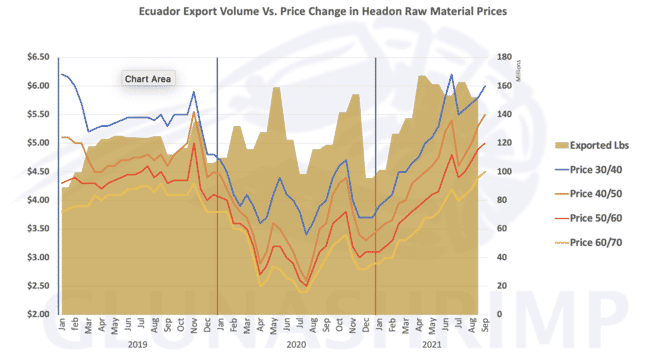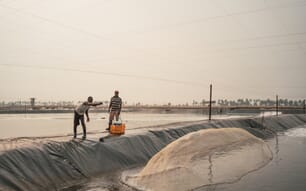
© Pierre Banoori Photography
Ecuador’s shrimp exports reached a record 841,000 tonnes in 2021 and, according to Luna, who runs Glunashrimp, a company that offers shrimp market advisory services, the country is on track to easily exceed this figure in 2022, as exports in January-June were up 35 percent compared to the same period last year.
“One million metric tonnes is the estimate, but it’s going to be higher [by 2-4 percent] because these end of the year months are higher than the first part of the year months,” Luna predicted.
The catalysts for growth
According to Luna, the growth in Ecuador’s shrimp production in the last decade was spurred on by a number of events. These included the Gulf of Mexico oil spill in 2010, which led to an increase in shrimp prices, and encouraged farmers to put ponds that has been mothballed after the outbreak of whitespot in 2000 back into production.

Another key event was the outbreak of early mortality syndrome (EMS) in Asia in 2012, which created a window for Ecuador’s shrimp farmers to export to China, causing a notable surge in demand for head-on shrimp from 2012 to 2016 in particular.
As most countries’ production levels recovered by 2018, so prices dropped, Luna noted – leading to most Ecuadorian shrimp farmers operating at a loss for at least five weeks of each year, inspiring innovation.

© Pierre Banoori Photography
“We’re not creative the rest of the year, it’s only those five weeks that we’re losing money that we get creative and we find ways to increase our productivity by lowering our costs. And the way to do it in your same farm… figure it like you’re building a second story… if you need to lower your cost again you need to build a third floor because what you need to do is – with the same management, the same people the same employees, the same infrastructure – you need to try to do more shrimp,” Luna explained.
This was done – in part – by increasing the stocking densities from 8-15 shrimp per square metre. But, as Luna explained, Ecuador is wary of attempting to farm at too high a density, as they are determined to ensure their shrimp stay healthy.
As a result, they looked into improving other aspects of production – in particular feed, from 2010 onwards. The arrival of a string of new feed mills in the 2010s helped farmer to improve shrimp growth rates from 1.1 g to 2.5 g per week. Other improvements included the adoption of nurseries and better pond management, including the combination of automatic feeders and aerators.
“We first tried the automatic feeders, they were great, they increased the growth rates and decreased the death rates, but when we combined them with aeration it went ballistic, we discovered new levels,” Luna recalled.
The result is that Ecuador’s 220,000 ha of shrimp farms produce an average of 4.5 tonnes per ha per year. Yet, Luna thinks that this figure could be much higher, as the majority of the country’s shrimp farms are still using extensive farming techniques.
“This means that we have a little ways to grow, because an efficient farm in Ecuador can produce that in one cycle, not in a year… so there’s a little bit of room for improvement,” Luna explained.
In particular he stressed the increased use of aerators in the 70 percent of the country’s farms that are still using minimal technology.

© Pierre Banoori Photography
“In three or four years, this is what you’re going to see – a little more aeration, a little more feeders, a little more machinery inside the ponds in order to reach the growth that we are not aiming for but have to do in order to become efficient and lower our production costs,” Luna explained.
With rising costs of feed, transport, packaging, combined with inflation, Luna feels that this process is essential. And he predicts that weekly shrimp growth rates will increase from 2.4 to 2.9 g, thanks in part to the adoption of autofeeders linked to microphones to improve feeding regimes.
Meanwhile, in the post-production side of the sector, the growth in demand for value-added products – especially in the US – is another challenge that needs to be met. Efficient systems will need to be established to allow Ecuador to compete with countries, such as India, where labour costs are lower, Luna concluded.





